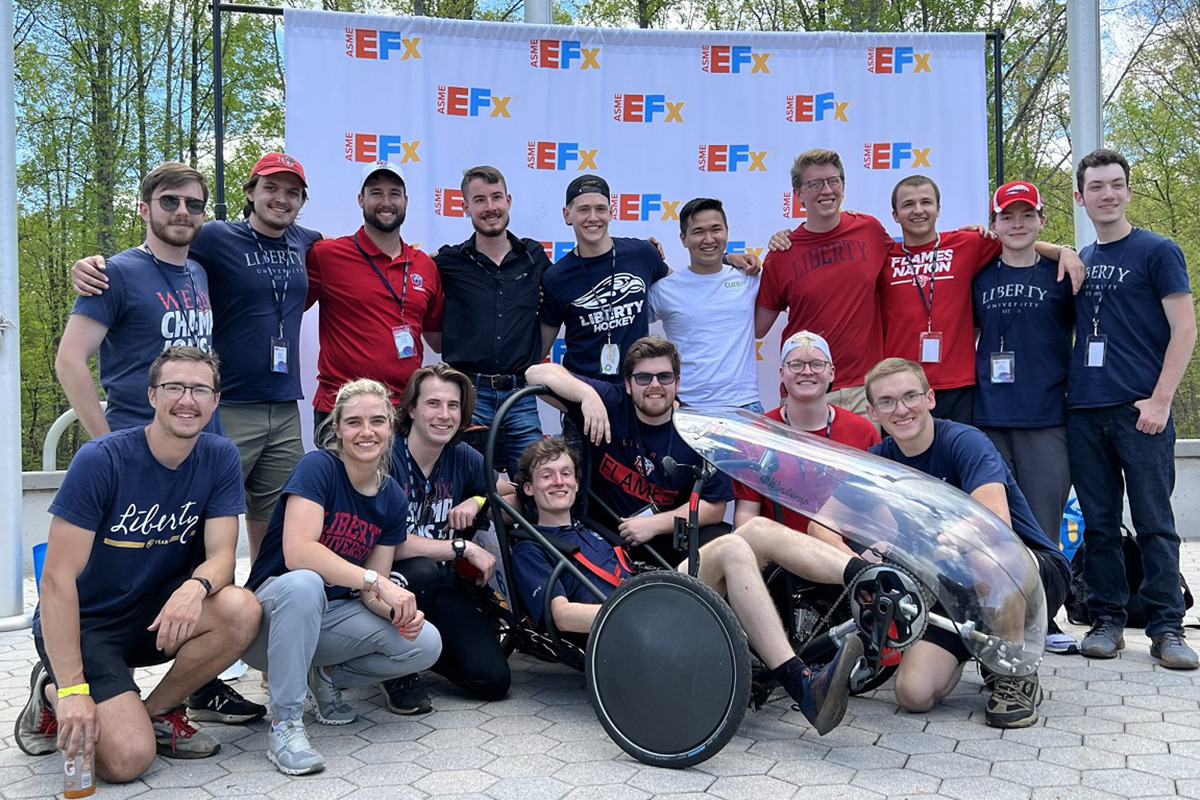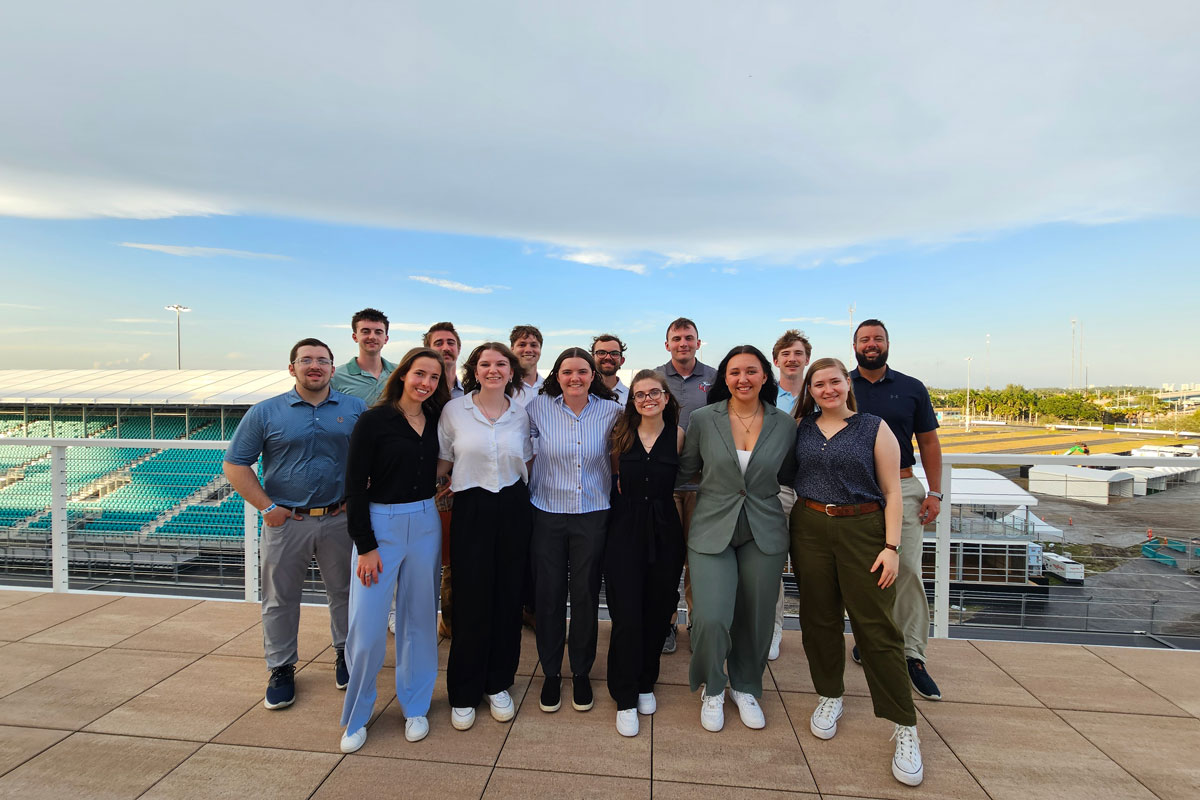Search News Archives
Filter News Articles
Additional Navigation
School of Engineering hosts national Human Powered Vehicle Challenge
April 25, 2023 : By Ted Allen - Office of Communications & Public Engagement

After three years of being held remotely, the Liberty University School of Engineering helped revive the ASME (American Society of Mechanical Engineers) Human Powered Vehicle Challenge national competition in-person last weekend, hosting 12 teams from colleges in Indiana, Wisconsin, and New York and as far away as Mexico and Puerto Rico.
The engineering design and innovation competition gives students the opportunity to network and apply engineering principles through the design, fabrication, and racing of human powered vehicles. The vehicles typically resemble three-wheeled recumbent bikes. This year’s instructions allowed for the inclusion of an electric-assisted pedal system.
The event was held at the Center for Engineering Research & Education (CERE) April 14-15, where the vehicles were driven on a .97-kilometer loop course. Most of the vehicles reached upwards of 30 mph.
The course featured plenty of obstacles, including a hair-pin turn, a slalom stretch around cones, a quick turn 6 feet in front of a traffic controller, rumblestrips, a speed bump, and nearly continuous uphills and downhills. The teams were tasked with picking up a parcel, a gallon of water, and a half a dozen eggs and carrying them safely through the course.
Liberty finished fourth place in design and 10th in the endurance race — due in part to a crash on the first lap — to finish seventh overall out of 21 teams that entered the competition, including nine that only submitted their designs online. Liberty’s team was composed of a blend of 20 mechanical, electrical, and industrial engineering as well as computer science students.
At the last in-person national competition in 2019, Liberty finished fifth at Michigan State. It took fourth place in a virtual competition in 2021 and looked to break into the top three this year, but a crash on the first lap of Saturday’s endurance race took the team out of the running.
School of Engineering Professor Dr. Tate Fonville, faculty advisor for the HPVC team, said there were supposed to be two HPVC competitions this year, on the East Coast and West Coast, but the West Coast event was canceled.
“God gave us exactly what we could handle and the proportion that we could handle it, and we made a great first impression,” he said, noting he recruited a pit crew of 30 student volunteers as well as emergency management support staff. “There are some things we could do better in the future, but it was a great event. Everybody at Liberty just really chipped in to make this event work and to be a success. The judges and the ASME (American Society of Mechanical Engineers) staff have all been very pleased with what we’ve had to offer.”

Mechanical engineering students Morgan Stalker and Elizabeth Wiese served as Liberty’s design lead and project manager, respectively.
“It was very exciting,” Wiese said. “We were very enthusiastic, and a little nervous for this. It brings a lot of peace to be able to do it on the home front in Lynchburg and to have everyone come here. We have an incredible team. They’re super knowledgeable on the technical side, but also great in helping bring the team together, which is very important.”
Liberty’s team also featured sub-teams that focused on drivetrain, electrical, fairing (a shell over the frame that deflects wind and reduces air drag aiding in aerodynamics), report, safety, and steering.
“They put a lot of man hours into the project,” Fonville said, noting that Stalker started designing the frame over the summer and then oversaw the manufacturing process out of the Hudgins Building, home to Liberty’s Civil Engineering Department.
“A lot of the people on the team say their biggest learning experience of engineering has not been in classes, but being on the team and learning about manufacturing and different materials and mechanical machines,” Wiese said. “So that has been encouraging to see what people learn and to see us developing a team atmosphere that’s encouraging for learning and growth.”
Stalker said the bike benefited from the electrical element, especially in accelerating on restarts, and other modifications and improvements on previous years’ entries.
“We definitely had a lower ground clearance and a much lower weight because we were using aluminum this year,” he said, noting that the frame weighed about 15 pounds, reducing the total weight to just over 65 pounds. “It ended up being significantly human powered, but that (electrical element) was required by the competition.”
Wiese, Stalker, and Sam Floyd, the fairing sub-team lead, served as the team’s three drivers during the endurance race, completing 20 laps after performing emergency repair work on the vehicle.
“A lot of teams were having to pit to take care of technical issues,” Fonville said. “We had some issues on our first lap, and our team scrambled and worked really hard to get our bike back up and running, so I was very impressed with them. They got back and running in about 20 minutes time, so with a major structural break like they had — a catastrophic failure on that first lap that would kill just about any team — our team got at it and did a really good job of getting back out there.”
The winner, the University of Wisconsin Madison, completed 60 laps in the allotted two and a half hours for the endurance race. The top three teams overall teams were the University of Central Florida (third in design, second in endurance), Missouri Science & Technology (second in design, sixth in endurance), and South Dakota State (first in design, ninth in endurance).

Also last weekend, the Liberty School of Engineering’s Steel Bridge and Concrete Canoe teams, both made up primarily of civil engineering students, traveled to Marshall University in Huntington, W.Va., for Virginias Regional competitions.
The four-member Steel Bridge team, led by faculty advisor Dr. Hyunjoong Kim and captained by Caleb Cauthorne, qualified for the national Student Steel Bridge Competition sponsored by the American Society of Civil Engineers (ASCE), set for June 2-3 in San Diego. They placed second out of seven teams, behind only Virginia Tech and ahead of Old Dominion University, Marshall, James Madison University, Bluefield State University, and West Virginia University. Liberty will be one of 40 teams (two each from 20 regions) at nationals out of a field of more than 130 that entered.
The team assembled the 1:10 scale model of a 24-foot truss bridge that spanned a 7-foot-wide river. The structure, designed to hold a load of 2,500 pounds, included 30-40 pieces of 3 feet or less put together with 100 nuts and bolts.
Liberty’s Concrete Canoe team placed second out of seven schools in the five 100-meter races that included men’s, women’s, and co-ed crews, and finished fifth overall. Only the top team, from Fairfield (W.Va.) University, made the cut for nationals in June.



